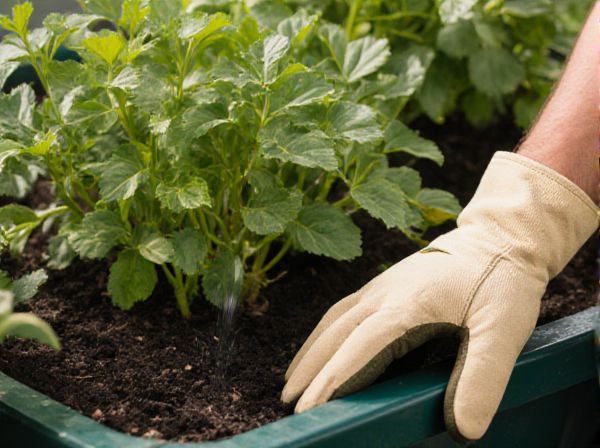
Sub-Irrigated Planter vs Top-Watering Pot Illustration
A sub-irrigated planter offers consistent moisture delivery directly to the roots, reducing water waste and promoting healthier plant growth compared to top-watering pots, which can lead to uneven moisture distribution and potential root rot. Sub-irrigated planters are especially efficient for container gardening, ensuring plants receive water from below, encouraging deeper root systems and minimizing surface evaporation. This method saves time and water, making sub-irrigated planters a sustainable choice for maintaining thriving plants in limited spaces.
Table of Comparison
| Feature | Sub-Irrigated Planter | Top-Watering Pot |
|---|---|---|
| Watering Method | Water delivered from the bottom via reservoir | Water applied directly to soil surface |
| Water Efficiency | High; reduces evaporation and runoff | Moderate; some water loss through evaporation |
| Plant Health | Promotes strong root growth, prevents overwatering | Risk of soil surface drying, variable root moisture |
| Maintenance | Reservoir refill needed; less frequent watering | Requires frequent watering, especially in hot climates |
| Ideal Use | Indoor and outdoor container gardening, drought-prone areas | Traditional container gardening with easy access |
| Cost | Generally higher due to specialized design | Lower; basic pot structure |
Introduction to Sub-Irrigated Planters and Top-Watering Pots
Sub-irrigated planters use a water reservoir at the base, allowing plants to absorb moisture through capillary action, which promotes efficient water usage and reduces root rot risks. Top-watering pots require direct water application from above, often leading to uneven moisture distribution and increased evaporation rates. Understanding these differences helps gardeners select containers that optimize plant health and conserve water.
How Sub-Irrigated Planters Work
Sub-irrigated planters operate through a self-watering system that delivers water from a reservoir beneath the soil, allowing plants to absorb moisture via capillary action. This design reduces water waste and promotes consistent hydration, encouraging deeper root growth and healthier plants. Unlike top-watering pots, sub-irrigated planters prevent surface evaporation and minimize the risk of overwatering or underwatering.
How Top-Watering Pots Function
Top-watering pots function by delivering water directly to the soil surface, allowing moisture to infiltrate through the soil profile and reach plant roots. This watering method relies on gravity to distribute water evenly, but often results in surface evaporation and uneven hydration if not monitored carefully. Unlike sub-irrigated planters, top-watering pots require more frequent watering and attention to prevent over- or under-watering.
Water Efficiency Comparison
Sub-irrigated planters maximize water efficiency by delivering moisture directly to plant roots through a reservoir, minimizing evaporation and runoff compared to top-watering pots that rely on surface watering and often suffer from water loss. Research indicates sub-irrigated systems can reduce water usage by up to 50% while promoting healthier root growth and sustained moisture levels. In contrast, top-watering pots require more frequent irrigation and risk uneven water distribution, leading to higher overall water consumption.
Impact on Plant Health and Growth
Sub-irrigated planters improve plant health by providing consistent moisture directly to the root zone, reducing water stress and promoting robust root development. Top-watering pots often lead to uneven soil moisture, which can cause root rot or dry patches, negatively impacting growth. Consistent hydration in sub-irrigated systems enhances nutrient uptake and supports stronger, healthier plants overall.
Maintenance and Upkeep Requirements
Sub-irrigated planters require less frequent watering due to their self-wicking reservoirs, reducing maintenance efforts and minimizing water waste. Top-watering pots demand regular watering and can lead to uneven moisture distribution, necessitating closer monitoring to prevent over- or under-watering. The reduced upkeep in sub-irrigated planters makes them ideal for consistent plant hydration with minimal intervention.
Suitability for Different Plant Types
Sub-irrigated planters excel with water-loving plants such as herbs, leafy greens, and tropical houseplants by providing consistent moisture from below, which reduces the risk of overwatering and root rot. Top-watering pots suit drought-tolerant plants like succulents and cacti because they allow for controlled watering and natural drying between cycles, preventing excess moisture buildup. Choosing the right watering method depends on the plant's moisture requirements and root sensitivity to ensure optimal growth and health.
Cost and Setup Considerations
Sub-irrigated planters (SIPs) typically have higher upfront costs due to their built-in water reservoirs and wicking systems, but they reduce long-term water expenses by minimizing evaporation and runoff. Top-watering pots are generally cheaper and easier to set up, requiring only basic containers and soil, but they often demand more frequent watering and can lead to inconsistent moisture levels. Evaluating initial investment against ongoing water use and maintenance helps determine the most cost-effective option for individual gardening needs.
Common Problems and Solutions
Sub-irrigated planters often face issues with algae growth and root rot due to excess moisture retention, which can be mitigated by using opaque containers and ensuring proper drainage. Top-watering pots commonly suffer from uneven water distribution and dry soil patches, solvable by consistent watering schedules and using moisture-retentive soil mixes. Choosing the appropriate container type and maintenance routine significantly improves plant health and reduces common watering problems.
Which System is Best for Your Container Garden?
Sub-irrigated planters (SIPs) use a self-watering reservoir to deliver moisture directly to plant roots, reducing water waste and promoting consistent hydration. Top-watering pots require frequent surface watering, which can lead to uneven moisture distribution and potential root stress. For container gardens prioritizing water efficiency and healthier root growth, sub-irrigated planters often outperform traditional top-watering pots.
Sub-Irrigated Planter vs Top-Watering Pot Infographic

 gardendif.com
gardendif.com